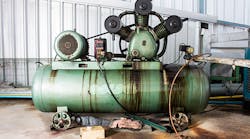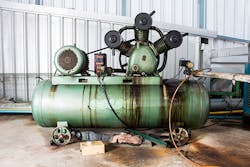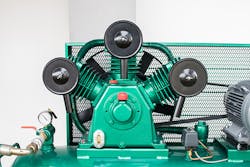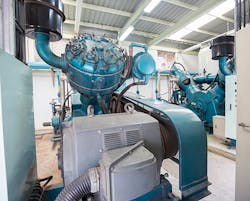Reciprocating compressors are used in many applications because they can compress air or gas in a wide range of pressure ratios and flowrates. They can offer excellent operational flexibilities for different services.
However, beside many advantages, there are some disadvantages and areas of concern. For example, pulsation is a major challenge for nearly any reciprocating compressor. It can impose many issues, including severe vibration, piping failures (due to fatigue), reduction in compressor efficiency, and errors in flow measurements. Also, the cylinder valves and unloaders can be sources of operational problems and reliability issues.
This article reviews several key areas of reciprocating compressor reliability, operation, and performance, including cylinder valve operation, lubrication, and pulsation.
Cylinder valves
The essential function of compressor cylinder valves is to permit flow in the desired direction and to block the flow in the opposite (undesired) direction. The set of inlet (suction) valves admits flow into the cylinder. The set of discharge valves is used to evacuate compressed air/gas from the cylinder.
The compressor manufacturer normally specifies valve type and size. There have always been discussions on the valve selection, details of cylinder valves, and the selection of the sub-vendor for valves. Usually there are few valve sub-vendors, sometimes only three or four manufacturers, which can offer quality cylinder valves with high performance and long-life for each required service and compressor.
The performance, reliability, and operation of cylinder valves are important topics for any reciprocating compressor. The efficiency and performance of cylinders are directly linked to operation, reliability, and losses of cylinder valves. The cylinder valve losses are proportional to the square of the flow velocity through the valve. In high-speed compressors, the valve area and internal passage cross-section are relatively smaller compared to low-speed machines, resulting in higher velocities through the cylinder valves (suction and discharge valves).
Many factors and parameters influence losses and the operation of cylinder valves such as compressor piston speed, the ratio of cylinder valve area to cylinder bore, the effective valve flow area, liquid induced stiction (static friction), and pulsation. Modern cylinder valves have improved compressor efficiency by an average of 3 to 5 percent with little to no loss in reliability, compared to the cylinder valves that were used 20 years ago. If the same trend continues, then it is usually recommended to evaluate and use modern and proven-in-service valves every seven to 10 years.
High-speed reciprocating compressors (greater than 900 rpm) are becoming more common in different services. Typically, valve losses are greater in high-speed reciprocating compressors. The behavior and dynamics of valves and associated fluid-dynamics are also more complicated in high-speed reciprocating compressors. In fact, current technologies and know-how of cylinder valves in the market have been developed for low-speed reciprocating compresses. As the results, low-speed compressors (less than 450 rpm) have better overall compressor efficiency and better cylinder valve life, when compared to high-speed compressors at similar pressure ratio conditions.
Of course, there are cylinder valves manufactured by reputable vendors, which can offer good life and performance. However, some cylinder valves have shown poor performance and low reliability in high-speed machines. Special care should be taken for the selection of cylinder valves and their operation and reliability in high-speed reciprocating compressors.
Lubrication
Dry Reciprocating Compressors. Many reciprocating compressors in air and gas services have been manufactured with non-lubricated (dry-type) cylinder/piston and rod-packing (rod pressure-packing) mechanisms. These machines are known as dry reciprocating compressors, and are popular for instrument air services, and for dry gas applications where oil in the compressed gas can cause problems. In those machines, piston rings and rod-packing are dry type (non-lubricated), and this prevents the contact of oil and compressed air/gas. Although these machines do not need oil for the cylinder/piston and rod-packing, they still require a lubrication oil system for the frame/crankcase.
Frame/Crankcase Lubrication. For lubricated (wet-type) reciprocating compressors, lubrication oil is needed for cylinder and rod-packing. This lubrication oil is generally different from the lubricant used for the frame (crankcase) lubrication, because ideally the frame (crankcase) lubrication system is entirely separate from the compressor cylinder and rod-packing lubrication system.
The lubrication oil viscosity used in the reciprocating compressor frame (crankcase) is typically ISO VG 100 or ISO VG 150. The latter is more common. Some rust and oxidation preventive additives and an anti-wear additive(s) could also be employed in the formulated lubrication oil. Traditionally, the same type of lubricant has been applied along the machinery train: driver, gear unit, and driven equipment in a train. Although this approach is not considered best reliability practice, it is still used in many plants.
In particular, small reciprocating compressors may use the same lubrication oil as their drivers if driven by an engine. For instance, the oil for a natural gas engine is typically used in the driven reciprocating compressor because it is readily available. In the same way, the oil for a diesel engine driver could be used in the compressor if the driver is a diesel engine. This commonality of lubrication oil may not be desired or recommended, but sometimes it reduces capital and operational costs, and eases maintenance work through the use of a single lubrication oil skid and single oil type for the driver and driven equipment.
The low-temperature properties of the lubrication oil selected are also important, as the oil should be able to flow under gravity from the (typically elevated) oil tank to the oil injection pump(s) on the compressor at ambient temperatures during winter, when temperature might be below 0°C.
Lubrication for Frames, Cylinders, and Rod-Packing Systems. For low pressure services, in non-critical compressors, the same lubrication oil may be used in the frame and in the cylinder and rod-packing systems to keep the lubrication strategy as simple as possible. However, it should be noted that such an over-simplified strategy often results in a compromised operation of cylinder and rod-packing systems. This strategy is recommended for small compressors, and low pressure and less critical services, where the shorter life of some machine components is determined to be acceptable compared to the cost and complexity of using two different lubricants and two different lubrication approaches. As a rough estimate, such a simplified configuration may be allowed for pressures below 25 Bar(g) and compressors smaller than 250 kW.
In general, a specially selected lubrication oil is required for the cylinder (cylinder/piston) and rod-packing systems, compared to the lubrication oil used for the frame/crankcase. Typically, the oil used for the cylinder/packing has a higher viscosity.
The type and details of the oil are also influenced by the details of the service, such as the composition of the compressed gas itself as well as its pressure and temperature. If the gas being compressed is a wet or sour one, or it has a special composition, then specially-selected cylinder lubrication oil should be used. For some reciprocating compressors, the lubrication oil for cylinder/packing is formulated with high viscosity base oil and a set of additives to prevent the oil being washed off the cylinder wall by the solvent-like action of the gas.
The viscosity of the lubrication oil required for the cylinders and packing mainly depends upon the specific gases being compressed and the highest discharge pressure and temperature encountered. Some reciprocating compressors handle two or three different gases in different cylinders. The cylinder with the most severe service on the compressor dictates the cylinder lubrication oil to be used, as most compressors will have only one oil injection system to serve all cylinders and rod-packings.
Under-Lubrication and Over-Lubrication. Both under-lubrication and over-lubrication should be avoided. Under-lubrication will result in heat, wear, or potentially seizure and operational problems. Over-lubrication may result in cylinder valve deposits, breakage problems, contamination of the downstream of the compressor, and premature failure of the packing.
Determining the oil feed rates to each cylinder and rod-packing set is important and often challenging. There are different methods for calculating or determining the oil feed rates to each cylinder and each packing. Most are rough calculations that are intended to provide only a starting point for setting the oil injection rates. The optimum values are confirmed by proper operation.
Early formulas used to quantify oil feed rates were based on the amount of lubricant necessary to provide an oil film sufficient to cover the cylinder-piston ring contact area. Traditionally, the oil feed rates to the main rod packing were calculated using the same formula as was used for the cylinders, except that the diameter of the rod is used instead of the bore of the cylinder. As a very rough example, a typical cylinder and packing consumption rate for an entire medium-sized medium-pressure reciprocating compressor could be three to 20 liters per day. During the break-in period, the oil volume should be increased, either by using a formula appropriate for break-in periods or by injecting 1.5 to 2.5 times the normal operating calculated value.
Pulsation control
Pulsation levels in a reciprocating compressor system could be high if left uncontrolled. Pulsation forces can reach significant magnitudes and unless attenuated, will result in noises, mechanical equipment damage, piping failures, or high vibration. A pulsation control solution should be formulated for each reciprocating compressor to minimize pulsation related problems (such as vibration, shaking forces, etc.) while maintaining maximum operational performance and efficiency.
Pulsation problems could be expected for all size and power ranges of reciprocating compressors. Of course, the shaking forces might be larger and more damaging in high pressure and more powerful machines. However, pulsation can still be a serious problem in so-called small machines.
The behavior of compressed gas, piping, and mechanical systems under pulsation is nonlinear, so nonlinear time-dependent simulations are usually required to obtain accurate predictions of the time-varying acoustical characteristics in the system, dynamic pressure drop, and the most effective pulsation control solutions.
Typically for smaller reciprocating compressors, higher speed ranges and wider speed variations have been used, and dealing with pulsation can be difficult and challenging. A good recommendation is to specify and enforce a suitable set of rules (such as “Design Approach 3” pulsation analysis as per API-618) for all reciprocating compressors, small, medium, and large sizes, even though reciprocating compressors are not ordered according to API codes. Such a comprehensive check and verification typically includes “Pulsation Analysis,” “Piping Restraint Analysis,” “Mechanical Natural Frequency Analysis” and most probably “Forced Response Studies.”
Finally, the proper sizing of pulsation bottles is required. Typically, pulsation bottles are special pressure vessels, and they need time for engineering and fabrication. Practically, the freeze and finalization of pulsation bottles is required to freeze the compressor general arrangement. Afterward, the connecting piping (downstream and upstream) will be designed accordingly. In this way, when the final pulsation study is done with connecting piping, the pulsation bottles are already manufactured or are in the last stages of fabrication. Therefore, the bottles cannot be changed or modified to accommodate the pulsation control requirements. (Note: it is wise to consider some margins for pulsation bottles, and they should be slightly overdesigned to meet final unpredictable situations.)
Amin Almasi is a machinery/mechanical consultant in Australia. He is chartered professional engineer of Engineers Australia (MIEAust CPEng – Mechanical) and IMechE (CEng MIMechE) in addition to a M.Sc. and B.Sc. in mechanical engineering and RPEQ (Registered Professional Engineer in Queensland). He specializes in mechanical equipment and machineries including centrifugal, screw and reciprocating compressors, gas turbines, steam turbines, engines, pumps, condition monitoring, reliability, as well as fire protection, power generation, water treatment, material handling and others. Almasi is an active member of Engineers Australia, IMechE, ASME, and SPE. He has authored more than 200 papers and articles dealing with rotating equipment, condition monitoring, maintenance, condition monitoring, fire protection, power generation, water treatment, material handling and reliability. Contact him at [email protected].



